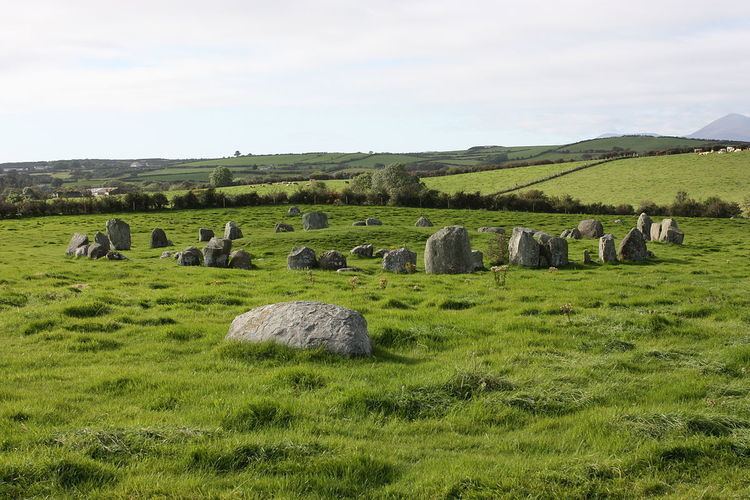Province Ulster | ||
 | ||
Address Bonecastle Rd, Downpatrick BT30 8ET, UK Hours Open today · Open 24 hoursWednesdayOpen 24 hoursThursdayOpen 24 hoursFridayOpen 24 hoursSaturdayOpen 24 hoursSundayOpen 24 hoursMondayOpen 24 hoursTuesdayOpen 24 hours Similar Saint Patrick Visitor Ce, Down County Museum, Tyrella Beach, Meehambee Dolmen, Knocknakilla | ||
Ballynoe stone circle 13
Ballynoe Stone Circle is a stone circle situated in the small hamlet of Ballynoe 2.5 miles (4 km) south of Downpatrick, County Down, Northern Ireland. It is near the disused railway station, reached by a long footpath off the main road, at grid ref: J481404. It is a large and impressive circle lying in cultivated lowland, less than 100 ft above sea level, in the heart of the fertile Lecale peninsula. (Latitude: 54.290937N Longitude: 5.726292W)
Contents
Ballynoe stone circle
Features
It is a large and complex site which appears as a large circle of over 50 closely spaced upright stones, some as much as six feet tall, with some small gaps, surrounding a space about 110 ft across. Two of the fallen stones have cavities which could be artificial cup-marks. The stones of the outer circle are nearly all composed of local Silurian grit, but a few are granite erratics. Two of the stones stand 7 ft apart immediately outside the circle on the west, and there are four outlying stones, two on the north-east (9 and 40 yards from the circle) and two on the south-west (9 and 50 yards from the circle). In the eastern half of the circle is an oval mound contained within a kerb with diameters of 46 and 58 ft, with the long axis on an east–west alignment. Immediately inside the circle on the west, opposite a pair of external stones, is an arc of six stones supporting the edge of a raised platform which occupies much the same position as the oval mound on the east. Excavations found that the 5-foot-high (1.5 m) mound was of stony earth, with a stone cairn at the core. Under the mound, between the cairn and the kerb were found a number of smooth boulders (baetyls) set in the old surface. Large cists were found at the east and west ends of the mound containing cremated bones.
It would seem that a kerbed round mound in the passage tomb tradition was added to the east end of a long cairn in the court tomb tradition, with a stone circle encompassing this composite structure. The site is the result of long development, and a late Neolithic to earlier Bronze Age date range is likely, as it seems to span several different building phases. Aubrey Burl has noted that a number of the characteristic features of the Ballynoe circle (its diameter, outlying stones and north–south alignment) are closely paralleled in Cumbria.
Excavations
The mound was excavated in 1937–38 by Dutch archaeologist, Dr AE Van Giffen, who died before publishing his examination of the site. The excavation concentrated on the mound, finding stone cists containing cremated bones. The only pottery recovered was from a small cremation pocket outside the mound and was a decorated rim sherd of Carrowkeel (passage grave) ware. There was a random scatter of cremation pockets between the mound and the stone circle. The excavations failed to satisfactorily explain the relationship between the various parts of the site.
